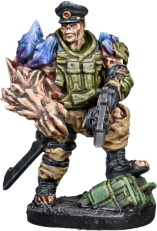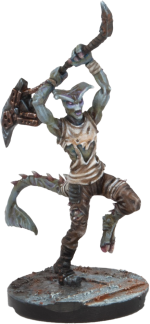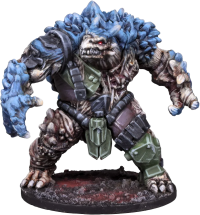The Plague can come in many variants due to it being an infection rather than a race.
About
Terminology
Officially, the GCPS classify the various Plague creatures as a series of stages. The initial Stage 1s are infected by the alien artefact directly. They infect Stage 2s, who in turn infect Stage 3s. Within this simple process is an additional level of detail. To accurately classify an individual creature you need to specify not only which stage it is at, but also what host creature it was based on. The mutagens create vastly different results depending on the genetic stock they have to work with. So, the full designation has a letter at the end to designate species. For example, Stage 1A (for human), Stage 3D (canine), Stage 2T (Teraton), and so on.
Of course, while that is all well and good in a formal paper on the subject back at base, in the field they get given all kinds of names. Most commonly they are simply referred to as 1st, 2nd or 3rd generations, or “jens” for short. Even less formal are terms like “Hellhounds”, Boom-stick” or “General”, and they’re just the repeatable ones.
In the end it doesn’t really matter what the troops on the ground call their foes, as long as they report the correct terminology to the intelligence division. They need accurate reports so that they can map out the spread and determine whether the Plague can be contained.
Classified: Sigma Level Clearance Only
Subject: Exo-threat recovered from Subar’s World, Preliminary findings.
Author: Professor Dennis Hide, ETCU Authorisation Number 471102-B
Black Site The Rock, Stratford Sector
The pathogen colloquially referred to as ‘The Plague’, is, quite simply, unlike anything previously encountered by the ETCU since its inception. It defies even basic taxonomic classification. It is not a bacteria. Normal staining procedures are inconclusive, but it lacks, as far as we can tell, organelles and appears incapable of extracellular reproduction. But it is not a virus either. It’s in vivo and in vitro behaviour, displaying clear motility and target selection, through an as-yet-undefined means, suggest more sophistication than that. More purpose.
It has a form of plasma membrane and must be more complex than a monocellular organism then. It resists lysis, even using picolasers and cold morganite fracturing. A definitive cell surface protein repertoire has thus far proven extremely difficult to capture though, even using the high-def spectrometry techniques developed by Etraki and Kain. Given the extreme virulence observed through numerous bioforms it may be there is no one surfaceome in the pathogen.
Antigenic variation is a well-known phenomenon amongst infectious micro-organisms. It enables them to evade a host’s immune response and even reinfect that host at a later date. But real-time recording of intracellular penetrations by this pathogen suggest something altogether more fascinating is happening. Somehow, ‘the Plague’ is able to pre-emptively alter its surface presentation, completely evading any immune response.
It is as if it is somehow pre-programmed to circumvent the biologies of every species-specific cell-type we have so far exposed it to - that number being one-hundred and thirty four, so far. How this is done is clearly related to the DNA packet contained within the pathogen and establishing the mechanism must be a priority if the GCPS is to stand a chance of halting its spread.
Developing protocols for this presents many challenges. Its extreme virulence means that so far only five sites, including this one, all classified ‘Black’, have so far been granted licence by the Council to hold samples. The speed at which an infection of the pathogen is able to hijack a host’s own circulatory and intracellular mechanisms make observation difficult and repetition dangerous. But further research is quite essential. It appears we are dealing with a new form of life, one designed to subvert, convert, and eradicate all others.
Plague Variants
| Human | Sphyr | Teratons |
|---|---|---|

|
 |
 |
 This wiki is not an official Mantic Games publication. |
